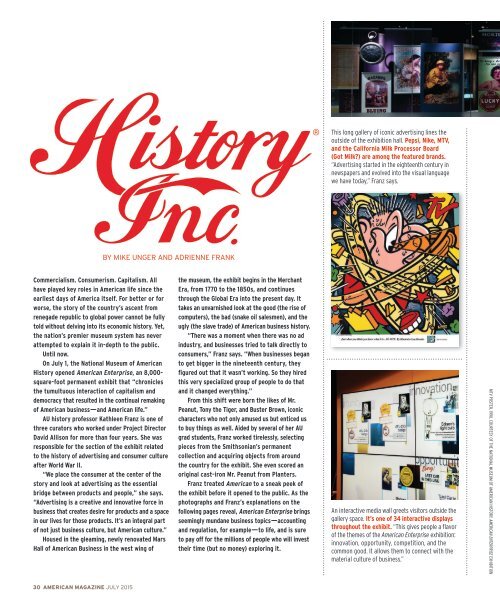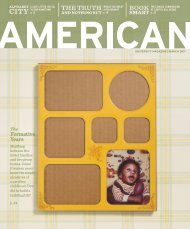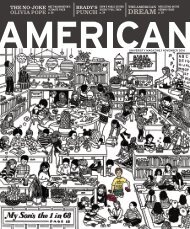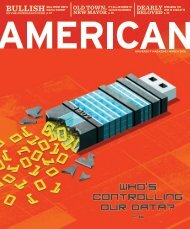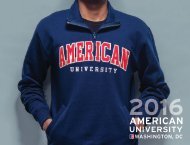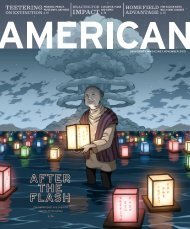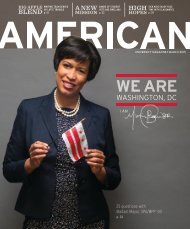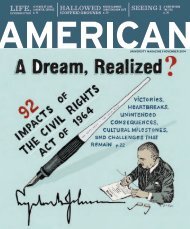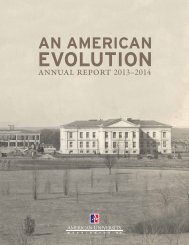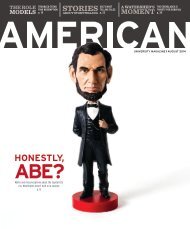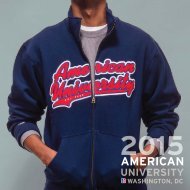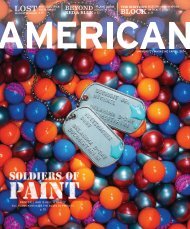American Magazine, July 2015
This issue, meet Maryland First Lady Yumi Hogan, learn about Kogod’s startup incubator, explore the Smithsonian’s new American Enterprise exhibit, hop on the Metro to Navy Yard—Ballpark, and get to know some of AU’s 1,200 Atlanta transplants. Also in the August issue: footwear on campus, 12 Eagles to follow on Twitter, and a new quiz with a tasty prize.
This issue, meet Maryland First Lady Yumi Hogan, learn about Kogod’s startup incubator, explore the Smithsonian’s new American Enterprise exhibit, hop on the Metro to Navy Yard—Ballpark, and get to know some of AU’s 1,200 Atlanta transplants. Also in the August issue: footwear on campus, 12 Eagles to follow on Twitter, and a new quiz with a tasty prize.
Create successful ePaper yourself
Turn your PDF publications into a flip-book with our unique Google optimized e-Paper software.
This long gallery of iconic advertising lines the<br />
outside of the exhibition hall. Pepsi, Nike, MTV,<br />
and the California Milk Processor Board<br />
(Got Milk?) are among the featured brands.<br />
“Advertising started in the eighteenth century in<br />
newspapers and evolved into the visual language<br />
we have today,” Franz says.<br />
BY MIKE UNGER AND ADRIENNE FRANK<br />
Commercialism. Consumerism. Capitalism. All<br />
have played key roles in <strong>American</strong> life since the<br />
earliest days of America itself. For better or for<br />
worse, the story of the country’s ascent from<br />
renegade republic to global power cannot be fully<br />
told without delving into its economic history. Yet,<br />
the nation’s premier museum system has never<br />
attempted to explain it in-depth to the public.<br />
Until now.<br />
On <strong>July</strong> 1, the National Museum of <strong>American</strong><br />
History opened <strong>American</strong> Enterprise, an 8,000-<br />
square-foot permanent exhibit that “chronicles<br />
the tumultuous interaction of capitalism and<br />
democracy that resulted in the continual remaking<br />
of <strong>American</strong> business—and <strong>American</strong> life.”<br />
AU history professor Kathleen Franz is one of<br />
three curators who worked under Project Director<br />
David Allison for more than four years. She was<br />
responsible for the section of the exhibit related<br />
to the history of advertising and consumer culture<br />
after World War II.<br />
“We place the consumer at the center of the<br />
story and look at advertising as the essential<br />
bridge between products and people,” she says.<br />
“Advertising is a creative and innovative force in<br />
business that creates desire for products and a space<br />
in our lives for those products. It’s an integral part<br />
of not just business culture, but <strong>American</strong> culture.”<br />
Housed in the gleaming, newly renovated Mars<br />
Hall of <strong>American</strong> Business in the west wing of<br />
the museum, the exhibit begins in the Merchant<br />
Era, from 1770 to the 1850s, and continues<br />
through the Global Era into the present day. It<br />
takes an unvarnished look at the good (the rise of<br />
computers), the bad (snake oil salesmen), and the<br />
ugly (the slave trade) of <strong>American</strong> business history.<br />
“There was a moment when there was no ad<br />
industry, and businesses tried to talk directly to<br />
consumers,” Franz says. “When businesses began<br />
to get bigger in the nineteenth century, they<br />
figured out that it wasn’t working. So they hired<br />
this very specialized group of people to do that<br />
and it changed everything.”<br />
From this shift were born the likes of Mr.<br />
Peanut, Tony the Tiger, and Buster Brown, iconic<br />
characters who not only amused us but enticed us<br />
to buy things as well. Aided by several of her AU<br />
grad students, Franz worked tirelessly, selecting<br />
pieces from the Smithsonian’s permanent<br />
collection and acquiring objects from around<br />
the country for the exhibit. She even scored an<br />
original cast-iron Mr. Peanut from Planters.<br />
Franz treated <strong>American</strong> to a sneak peek of<br />
the exhibit before it opened to the public. As the<br />
photographs and Franz’s explanations on the<br />
following pages reveal, <strong>American</strong> Enterprise brings<br />
seemingly mundane business topics—accounting<br />
and regulation, for example—to life, and is sure<br />
to pay off for the millions of people who will invest<br />
their time (but no money) exploring it.<br />
An interactive media wall greets visitors outside the<br />
gallery space. It’s one of 34 interactive displays<br />
throughout the exhibit. “This gives people a flavor<br />
of the themes of the <strong>American</strong> Enterprise exhibition:<br />
innovation, opportunity, competition, and the<br />
common good. It allows them to connect with the<br />
material culture of business.”<br />
MTV POSTER, 1990, COURTESY OF THE NATIONAL MUSEUM OF AMERICAN HISTORY, AMERICAN ENTERPRISE EXHIBITION<br />
30 AMERICAN MAGAZINE JULY <strong>2015</strong>


